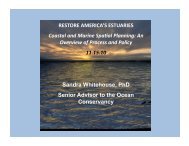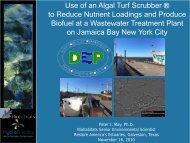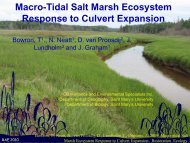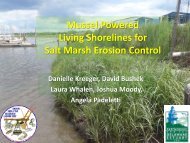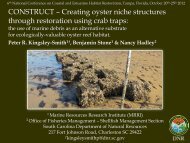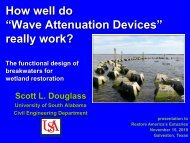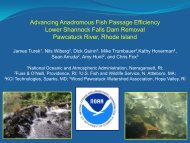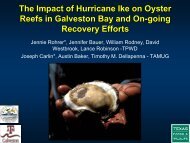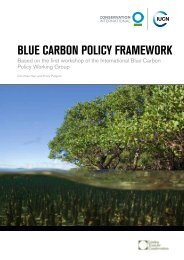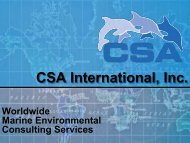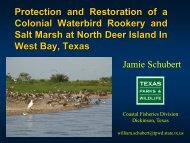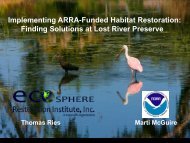The Use of Low Cost Breakwaters for Mangrove Restoration in ...
The Use of Low Cost Breakwaters for Mangrove Restoration in ...
The Use of Low Cost Breakwaters for Mangrove Restoration in ...
Create successful ePaper yourself
Turn your PDF publications into a flip-book with our unique Google optimized e-Paper software.
<strong>The</strong> <strong>Use</strong> <strong>of</strong> <strong>Low</strong> <strong>Cost</strong><br />
<strong>Breakwaters</strong> <strong>for</strong><br />
<strong>Mangrove</strong> <strong>Restoration</strong><br />
<strong>in</strong> Muddy Foreshores<br />
Douglas A. Gaffney, P.E.<br />
Ranata Robertson<br />
October 23, 2012
<strong>The</strong> <strong>Use</strong> <strong>of</strong> <strong>Low</strong> <strong>Cost</strong> <strong>Breakwaters</strong> <strong>for</strong><br />
<strong>Mangrove</strong> <strong>Restoration</strong> <strong>in</strong> Muddy Foreshores<br />
� Geological Sett<strong>in</strong>g<br />
� <strong>Mangrove</strong>s <strong>in</strong> Guyana<br />
� Breakwater Design<br />
� Design at Victoria Guyana<br />
� Construction<br />
� Integrated Approach to <strong>Mangrove</strong> <strong>Restoration</strong>
Geological Sett<strong>in</strong>g<br />
�Muddy Foreshores<br />
�Specific Gravity<br />
�Atterberg’s Limit<br />
�Shear Strength<br />
�Allison and Lee, 2004
Mudbanks
Allison and Lee, 2004
Lead<strong>in</strong>g Edge <strong>of</strong> the Mud Bank
Trail<strong>in</strong>g Edge <strong>of</strong> the Mud Bank
<strong>Mangrove</strong>s <strong>in</strong> Guyana<br />
� Species<br />
� Erosion<br />
� Seawalls
<strong>Mangrove</strong>s <strong>in</strong> Guyana<br />
Guyana’s coastl<strong>in</strong>e is 430 Km. Portions <strong>of</strong> the upland lie<br />
0.5m to 1.0m below sea level, and are protected by a system<br />
<strong>of</strong> sea defences amount<strong>in</strong>g to 340km <strong>in</strong> length. Out <strong>of</strong> this<br />
340 Km, sixty five percent (65%) is protected by Natural Sea<br />
Defence (<strong>Mangrove</strong>s).
<strong>Mangrove</strong>s <strong>in</strong> Guyana<br />
Guyana currently has 22,632 hectares <strong>of</strong> mangrove <strong>for</strong>est.<br />
Avicennia germa<strong>in</strong>as (black mangrove) and Laguncularia<br />
(white mangrove) is found on the coast while Rhizophora<br />
mangle (red mangrove) is found <strong>in</strong> the river<strong>in</strong>e areas.
Black and White <strong>Mangrove</strong>
Typical <strong>Mangrove</strong><br />
Cross Section
Crane,<br />
WCD
Crane,<br />
WCD
Crane,<br />
WCD
Standard Breakwater Design<br />
� Sand (Tombolos and Salients)<br />
� Galveston<br />
� Mordecai Island
Types <strong>of</strong> <strong>Breakwaters</strong><br />
� In relation to the water level<br />
� Emergent<br />
� Submerged (also called sill)<br />
� Attached or Detached<br />
� Crest Width<br />
� Narrow<br />
� Wide<br />
� Segmented<br />
� By shape or orientation<br />
� Generally shore parallel<br />
� Chevron (<strong>for</strong> bi-directional waves)<br />
� Angled
Detached Segmented Breakwater<br />
� Note the salients and<br />
tombolos
Nearshore Curved Breakwater<br />
Mordecai Island, NJ<br />
� Note the change<br />
<strong>in</strong> wave energy<br />
from one side to<br />
the other
Example Cross Section
NEARSHORE BREAKWATERS<br />
Galveston Island State Park, TX
Scour Apron<br />
Grand Isle, Louisiana
Scour Apron (re<strong>in</strong><strong>for</strong>ces the foundation)<br />
Fly Ash Lagoon, PA
Design at Victoria, GY<br />
�Geotextile Tubes and scour apron
Modell<strong>in</strong>g the Tube
Plan at Victoria, ECD<br />
Plan View
Design Objectives<br />
� Two (2) 50 meter sand filled geotextile tubes<br />
� 20 ft circumference (8 feet wide by 4 feet high)<br />
� sand-filled (260 cubic meters plus losses and anchor tubes)<br />
� Two (2) 52 meter X 5.4 m scour aprons<br />
� Double layer due to s<strong>of</strong>t foundation<br />
� Oriented to be perpendicular to <strong>in</strong>cident waves at 60<br />
degrees from magnetic north<br />
� Designed to encourage tombolo growth which will<br />
capture more sediment and mud to raise the <strong>for</strong>seshore:<br />
� proper elevation will promote revegetation<br />
� <strong>Breakwaters</strong> will reduce future storm energy<br />
� <strong>Breakwaters</strong> will reduce focus<strong>in</strong>g <strong>of</strong> reflected wave energy <strong>of</strong>f<br />
the seawall
Construction<br />
� Geotextile Tubes and scour apron<br />
� Fill<strong>in</strong>g Equipment
Fill Material<br />
Fill Gradation<br />
Tube Foundation<br />
Tube Alignment<br />
Tube Anchorage<br />
Tube Overlaps<br />
Tube Fill<strong>in</strong>g
Sand on Site
Integrated Approach<br />
�Contrast to “no eng<strong>in</strong>eer<strong>in</strong>g”<br />
�Don’t constra<strong>in</strong> mangroves beh<strong>in</strong>d seawalls
Lewis, 2004<br />
1. Get the hydrology right first.<br />
2. Do not build a nursery, grow mangroves and just plant some area<br />
currently devoid <strong>of</strong> mangroves (like) a convenient mudflat). <strong>The</strong>re is a<br />
reason why mangroves are not already there or were not there <strong>in</strong> the<br />
recent past or have disappeared recently.<br />
3. Once you f<strong>in</strong>d out why, see if you can correct the conditions that<br />
currently prevent natural colonization <strong>of</strong> the selected mangrove<br />
restoration site. If you cannot correct those conditions, pick another<br />
site.<br />
.
Lewis, 2004<br />
4. <strong>Use</strong> a reference mangrove site <strong>for</strong> exam<strong>in</strong><strong>in</strong>g normal hydrology <strong>for</strong><br />
mangroves <strong>in</strong> your particular area. Either <strong>in</strong>stall tide gauges and measure<br />
the tidal hydrology <strong>of</strong> a reference mangrove <strong>for</strong>est or use the surveyed<br />
elevation <strong>of</strong> a reference mangrove <strong>for</strong>est floor as a surrogate <strong>for</strong><br />
hydrology, and establish those same range <strong>of</strong> elevations at your<br />
restoration site or restore the same hydrology to an impounded mangrove<br />
by breach<strong>in</strong>g the dikes <strong>in</strong> the right places.
<strong>The</strong> <strong>Use</strong> <strong>of</strong> <strong>Low</strong> <strong>Cost</strong> <strong>Breakwaters</strong> <strong>for</strong><br />
<strong>Mangrove</strong> <strong>Restoration</strong> <strong>in</strong> Muddy Foreshores<br />
�Conclusions<br />
� <strong>Breakwaters</strong>, specifically ones constructed <strong>of</strong><br />
geotextile tubes, may <strong>of</strong>fer a relatively low<br />
cost approach to restor<strong>in</strong>g and protect<strong>in</strong>g<br />
mangroves<br />
� Typical Breakwater Design has to be<br />
modified to suit the environment<br />
� Site data and an understand<strong>in</strong>g <strong>of</strong> the<br />
environment is crucial




